Kuroiler vs. Noiler: Deciphering Poultry’s Elite Duo
In my relentless quest to comprehend the nuanced intricacies of the poultry industry, a compelling debate repeatedly surfaced: Kuroiler vs. Noiler.
These two poultry champions, both celebrated for their distinctive attributes, have caused quite a stir among poultry enthusiasts and farmers alike. Determined to shed light on this discussion, I embarked on a detailed journey to decipher the unique characteristics of each breed.
The direct response? Both Kuroiler and Noiler are exemplary breeds renowned for their dual-purpose utility, primarily meat and egg production. However, they do have their distinctions which I will elucidate below.
1. Origin and Introduction:
- Kuroiler: Introduced by the Keggfarms in India, Kuroiler was developed as a hardy breed suitable for backyard farming. It was tailor-made for resource-poor, marginal farmers, enabling them to earn a sustainable livelihood.
- Noiler: The Noiler, on the other hand, has its roots in Nigeria. Introduced as a solution to meet the country’s growing demand for chicken meat, this breed quickly gained popularity due to its performance under various local farming conditions.
2. Growth and Production:
- Kuroiler: Kuroilers are celebrated for their rapid growth. When adequately fed, they can attain market weight in a remarkably short span. Furthermore, female Kuroilers have impressive egg-laying capabilities, producing more eggs than indigenous breeds.
- Noiler: Noilers, too, are known for their speedy growth and can reach market-ready weights in a short duration. Their egg-laying prowess is commendable, making them a favorite among farmers who prioritize both meat and egg production.
3. Adaptability and Maintenance:
- Kuroiler: Bred specifically for Indian rural settings, Kuroilers have a robust constitution. They can thrive on the agricultural and household waste, demonstrating resistance to diseases prevalent in free-range settings.
- Noiler: Acclimatized to the Nigerian environment, Noilers showcase hardiness and resilience. They can be reared in both intensive and free-range systems, making them versatile and adaptive to varied farming practices.
4. Market Value and Popularity:
- Kuroiler: Kuroilers, due to their dual-purpose utility and adaptability, have found favor in several Asian and African countries, not just India. Their ability to provide both meat and eggs efficiently gives them a competitive edge in the market.
- Noiler: While Noilers dominate the Nigerian poultry scene, their fame is now spreading to other West African countries. Their efficient meat production coupled with satisfactory egg yields makes them a coveted choice for many poultry farmers.
ALSO SEE: Are Broilers Male or Female?
In Conclusion:
While both Kuroiler and Noiler share several similarities, like rapid growth and dual-purpose utility, their origins, adaptability, and slight variations in performance set them apart.
For farmers and poultry enthusiasts, the choice between Kuroiler and Noiler should hinge on specific requirements, local conditions, and market demands.
My journey into the world of these poultry giants has been enlightening, and I hope my findings assist you in making an informed decision in the Kuroiler vs. Noiler debate.
FAQs on Kuroiler vs. Noiler
- Q: What are Kuroiler and Noiler? A: Both are poultry breeds renowned for their dual-purpose utility, mainly meat and egg production.
- Q: Where did Kuroiler originate? A: Kuroiler was introduced by Keggfarms in India.
- Q: What about Noiler’s origin? A: Noiler has its roots in Nigeria.
- Q: Are Kuroilers suitable for backyard farming? A: Yes, Kuroilers were developed specifically for backyard farming, especially for resource-poor, marginal farmers.
- Q: How quickly do Kuroilers grow? A: Kuroilers are known for their rapid growth and can reach market weight quickly when properly fed.
- Q: Do Noilers grow at the same rate as Kuroilers? A: Noilers also exhibit speedy growth, reaching market-ready weights in a short duration.
- Q: Which breed lays more eggs, Kuroiler or Noiler? A: Both breeds have commendable egg-laying capabilities, but female Kuroilers produce more eggs than many indigenous breeds.
- Q: Are Kuroilers disease-resistant? A: Yes, Kuroilers demonstrate resistance to diseases common in free-range settings.
- Q: Can Noilers thrive in varied farming practices? A: Absolutely! Noilers are versatile and can be reared in both intensive and free-range systems.
- Q: Which breed has a broader market presence, Kuroiler or Noiler? A: While Kuroilers are popular in several Asian and African countries, Noilers predominantly dominate the Nigerian poultry scene.
- Q: Can Kuroilers feed on household waste? A: Yes, Kuroilers can thrive on agricultural and household waste.
- Q: Are Noilers adaptive to different environments? A: Noilers are acclimatized to the Nigerian environment, showcasing resilience and adaptability.
- Q: Why was Kuroiler developed? A: Kuroiler was developed as a hardy breed for resource-poor, marginal farmers to earn a sustainable livelihood.
- Q: What spurred the introduction of Noilers? A: Noilers were introduced to meet Nigeria’s growing demand for chicken meat.
- Q: Is the egg yield of Noilers satisfactory? A: Yes, Noilers have a commendable egg yield, making them popular among farmers.
- Q: Are Kuroilers and Noilers similar? A: They share several similarities, but their origins, adaptability, and slight performance variations set them apart.
- Q: Which breed has a competitive edge in the market? A: Kuroilers, due to their adaptability and dual-purpose utility, have an edge in many markets, especially outside Nigeria.
- Q: How widespread is Noiler’s fame? A: While dominant in Nigeria, Noiler’s fame is spreading to other West African countries.
- Q: Which breed is better for meat production? A: Both breeds are efficient for meat production, but specific performance may vary based on rearing conditions.
- Q: Are Kuroilers more popular than Noilers outside Nigeria? A: Kuroilers have found favor in various Asian and African countries due to their adaptability and dual-purpose utility.


